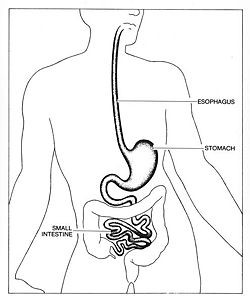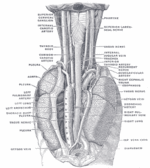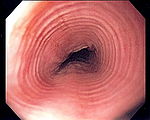Esophagus
The esophagus is an organ of the digestive system that consists of a long tube that transports food from the pharynx down to the stomach. There are many diseases that one can get in the esophagus, and there are treatments to cure these diseases.
Function
The function of the esophagus is to peristalsis food down to the stomach. Peristalsis is moving food down by contracting in a coordinated fashion from the upper to the lower esophagus [1]. The food is passed from the mouth to the pharynx, and then to the esophagus. From the esophagus, the food is sent down to the stomach [2].
Location
The esophagus goes behind the trachea, also known as the windpipe, and then the heart, and in front of the spine. Right before it enters into the stomach, the esophagus passes through the diaphragm [1].
The Anatomy
The esophagus is about 8 inches long [1]. Its surface is made up of squamous mucosa [3]. This means that the mucosa is made up of squamous cells. These cells are like those seen on the surface of the skin. [4]. It is made up of three main parts, the upper esophageal sphincter, the tube, and the lower esophageal sphincter. The upper esophageal sphincter is a bundle of muscles at the top of the esophagus that are under conscious control when vomiting, breathing, and eating. This keeps secretions and food from going down the trachea. The lower esophageal sphincter is another bundle of muscles at the lower end of the esophagus. These muscles meet the esophagus to the stomach. These are involuntary muscles and they make sure that no food travels back up the esophagus. [1].

Diseases
There are many different diseases or disorders that the esophagus can have, including: Gastroesophogeal Reflux Disease (GERD), Barretts Esophagus (Intestinal Metaplasia of the Esophagus), Esophogeal Cancer, Esophogeal Strictures/Schatzki Rings, and Achalasia/Motility problems[3].
Gastrosphogeal Reflux Disease (GERD) is where someone has a problem with acid and other stomach contents refluxing up from the stomach up into the esophagus. The damage that will be caused by the acid is called esophagitis. The most common symptom of Gastrosphogeal Reflux Disease is heartburn, but some patients may show signs of nausea, vomiting, chest pain, and regurgitation symptoms. Gastrosphogeal Reflux Disease may cause coughing, hoarseness, and aggravate asthma in some patients. It can be difficult to determine what symptoms are being caused by Gastrosphogeal Reflux Disease[3].
The Barrattes Esophagus, or Intestinal Metaplasia of the Esophagus, is an area of the esophagus that no longer has squamous mucosa. Instead, the area has turned into glandular mucosa. If the area looks like small intestinal mucosa under the microscope it might turn into esophageal cancer. Barretts esophagus is usually assumed to be related to Gastrosphogeal Reflux Disease and damage caused by Gastrosphogeal Reflux Disease, although it may be found at birth in some patients. Patients with Barretts esophagus will usually have the same symptoms as those with Gastrosphogeal Reflux Disease [3].
Esophogeal cancer has two major forms but, has also been seen in several other forms. These two major forms are squamous cell carcinoma and adenocarcinoma. For squamous cell carcinomas, smoking and alcohol use are the two major risk factors. Not all of all adenocarcinomas come from areas of Barretts esophagus. Symptoms of this cancer include: difficulty swallowing, weight loss, and poor appetite. These symptoms are not uncommon and there might symptoms such as problems with coughing, hoarseness, and aggravate asthma [3].
Esophogeal Strictures/Schatzki Rings are where strictures and rings are narrow areas of the esophagus that may cause problems with the passage of food. Most times, these are caused by acid damage that is related to Gastrosphogeal Reflux Disease. The strictures or rings can be related to toxic ingestions, congenital problems, or autoimmune conditions. Trouble with swallowing and passing food into the stomach are the two most common symptoms. These sensations are usually felt in the chest but not limited to the chest. They can also be felt in the back of the throat. The problem may be with all swallows or just be intermittent [3].
Achalasia/Motility problems will affect the normal peristalsis of the esophagus. In achalasia, the esophagus does not coordinate the muscle contraction and the lower esophageal sphincter does not relax. Common symptoms of motility problems include: chest pain, heartburn, and trouble swallowing [3].
Cures for Diseases
Cancer of the esophagus can be cured by multidisciplinary. People with early stages of a tumor in the esophagus can be treated with: endoscopic mucosal resection (EMR), photodynamic therapy (PDT) or minimally invasive surgery. People that have a tumor that is more mature should undergo multimodality therapy with chemotherapy and radiation therapy followed by surgery. Pre-operation therapy increases the chances of complete removal and cure rate[5].
Video
Over time, Gastroesophageal Reflux Disease, or GERD, can lead to Barretts esophagus, dysplasia or even esophagus cancer (adenocarcinoma.) This video shows how an esophagectomy removes abnormal or cancerous cells by removing part of the esophagus, the top part of the stomach and nearby lymph nodes. It also discusses some of the risks and possible complications of this operation. Mayo Clinic has a very large team with an international reputation for its skill in diagnosing and treating reflux, Barretts esophagus and esophagus cancer
References
- ↑ 1.0 1.1 1.2 1.3 Author Unknown. The Esophagus WebMD. Web. Accessed 24 April 2013.
- ↑ Wile, Jay L., and Shannon, Marilyn M. The Human Body: Fearfully and Wonderfully Made!. Cincinnati: Apologia Educational Ministries, Inc., 2001. 383. Print.
- ↑ 3.0 3.1 3.2 3.3 3.4 3.5 3.6 Author Unknown. The Esophagus Alaska Digestive Center. Web. Accessed 24 April 2013.
- ↑ Author unknown. Esophagus with Reactive or Reflux Changes, not including Barrett's Esophagus Johns Hopkins. Web. Accessed 24 April 2013.
- ↑ Author Unknown. Treatments for Esophageal Diseases California Heart and Lung Surgery Medical Center Alexander Marmureany MD. Web. Accessed 8 May 2013 .
| ||||||||||||||||||||



